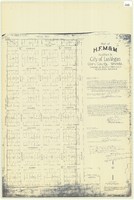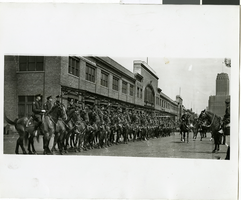Search the Special Collections and Archives Portal
Search Results

Plat of H.F.M & M addition to city of Las Vegas, Clark County, Nevada, comprising the west 1/2 of N.W. 1/4 Sec. 27, Twp. 20 S., R. 61 E., M.D.B & M, March 8, 1924
Date
1924-03-08
Description
Blue-line print ; 74 x 36 cm on sheet 79 x 61 cm. Survey was competed on March 8, 1924. Signed by the owners of the piece of property for the addition Roy W. Martin, Forest R. Mildren, William E. Ferron, and A. W. Ham, signed by the surveyor J.T. McWilliams, and notarized on March 31, 1924. Approved by the Board of City Commissioners and signed by the major W. C. German and by Florence S. Doherty, city clerk, on April 1, 1924. Recorded in Book 1 of plats, page 47. Includes township and range grid.
Image

Photograph of Howard Hughes with Senator Harry P. Cain, Culver City, California, August 16, 1947
Date
1947-08-16
Archival Collection
Description
A view of Howard Hughes (right) after being asked about his controversial XF-11 photo reconnaissance plane by Senator Harry Cain (left), Republican of Washington, in Culver City, California.
Image
City Lights, Atlantic City, New Jersey video recording, approximately 1960 to 2009
Level of Description
File
Archival Collection
Bill Moore Professional Papers
To request this item in person:
Collection Number: MS-00597
Collection Name: Bill Moore Professional Papers
Box/Folder: Digital File 00 (Restrictions apply)
Collection Name: Bill Moore Professional Papers
Box/Folder: Digital File 00 (Restrictions apply)
Archival Component

Photograph of a crowd of people awaiting the arrival of Howard Hughes, New York, July 14, 1938
Date
1938-07-14
Archival Collection
Description
The black and white view of a crowd of people awaiting the arrival of Howard Hughes in his Lockheed 14 aircraft at Floyd Bennett Airport, New York. This final landing for Hughes marked the end of his Round The World flight.
Image

Photograph of the XF-11 prior to its first test flight in Culver City, California July 7, 1947
Date
1947
Archival Collection
Description
Transcribed from press release attached to back of photo: "NEW-DESIGN PHOTO PLANE COMPLETED CULVER CITY, Calif., July 7 -- test-flown today for the first time, the new XF-11 was revealed as one of the world's fastest long-range photographic planes. It was designed and built by Howard Hughes in conjunction with the Air Materiel command engineers. Army officials said that it can attain a speed of more than 400 miles per hour and a ceiling of more than 40,000 feet. The plane has a pressurized cabin making it unnecessary for the crew to use oxygen masks. Outstanding features include a full-span flap, unique eight-camera layout and exceptionally fast take-off." Transcribed from photo sleeve: "Howard Hughes sits in the cockpit of the XF-11, a reconnaissance plane that Hughes built and designed in conjunction with Air Materiel Command engineers. Hughes is preparing for his first test flight in Culver City, California July 7, 1947."
Image

Photograph of police men awaiting the arrival of Howard Hughes, New York, July 15, 1938
Date
1938-07-15
Archival Collection
Description
Typed onto a piece of paper attached to the image: "Police lined up ready for the start of Howard Hughes parade. 7/15/38."
Image

Photograph of the fuselage of the Hughes Flying Boat leaving its Culver City hangar, California, 1946
Date
1946
Archival Collection
Description
A section of Howard Hughes' "Spruce Goose" or "Flying Boat" being moved (with a police escort) from the Hughes Aircraft plant in Culver City, California to Terminal Island in the Los Angeles Harbor where the plane was assembled in June of 1946.
Image

Photograph of Howard Hughes, New York, New York, September 12, 1946
Date
1946-09-12
Archival Collection
Description
A view of Howard Hughes saying a few words for a radio audience just after arriving in New York, New York.
Image

Photograph of the landing of Howard Hughes' Lockheed 14 aircraft, New York, July 14, 1938
Date
1938-07-14
Archival Collection
Description
The black and white view of Howard Hughes' Lockheed 14 aircraft performing its final landing on the Round the World flight at Floyd Bennett Airport, New York. Typed onto a piece of paper attached to the image: "Howard Hughes lands at Floyd Bennett Field. 7/38."
Image

Photograph of Howard Hughes in the cockpit of the first XF-11, Culver City, California, 1946
Date
1946
Archival Collection
Description
Howard Hughes in the cockpit of his XF-11 before its first test flight.
Image
Pagination
Refine my results
Content Type
Creator or Contributor
Subject
Archival Collection
Digital Project
Resource Type
Year
Material Type
Place
Language
Records Classification
